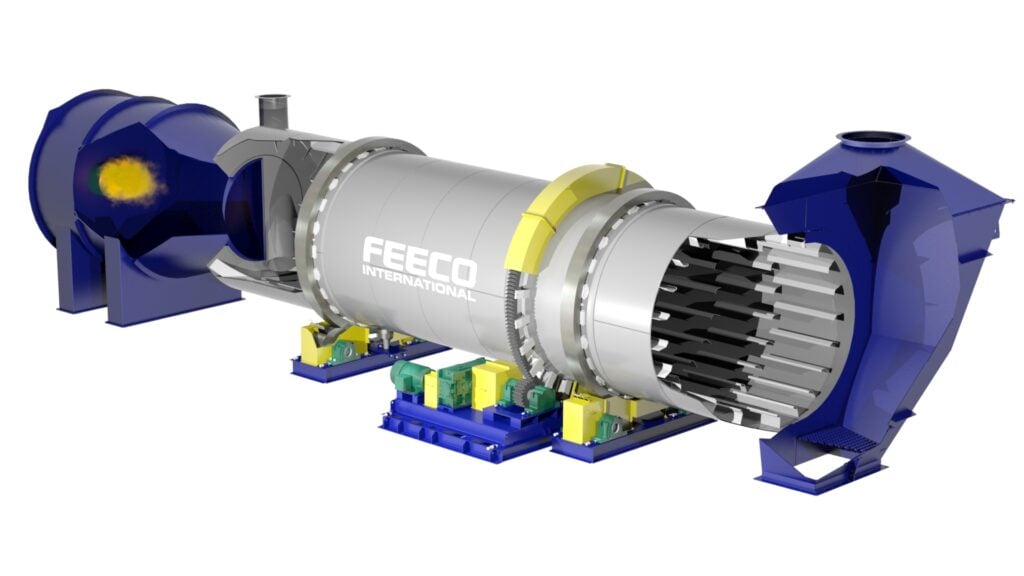Though not required in all aluminum recycling operations, aluminum chip dryers are paramount in secondary aluminum production settings processing scrap contaminated with hydrocarbons, helping to ensure a safe environment, a high-quality end product, and maximum aluminum recovery.
The aluminum industry is experiencing strong demand as several factors, such as increasing use in electric vehicles, the transition to a low-carbon economy, and the growing use of aluminum for beverage packaging, have producers looking for more of the lightweight metal. The scramble for aluminum, paired with a push for more sustainable production practices, has the industry investing more in secondary aluminum production, or aluminum recycling, causing a rise in demand for chip or swarf dryers.
Here’s a look at why these dryers are necessary and how they work.
When is an Aluminum Chip Dryer Necessary?
The process of recycling aluminum varies depending on several factors, including the type of scrap collected and the specific alloys to be produced, among other parameters.
When oils and organic contaminants or hydrocarbons are present in the aluminum scrap, an aluminum chip dryer is an essential process component. Chip dryers are therefore common in secondary facilities processing aluminum materials such as borings, machine chips, turnings, or oily scrap. These materials, generally referred to as either aluminum chips or swarf, are often subject to use in the presence of lubricants, coolants, grease, and machining oils, which ultimately contaminate the aluminum and must be removed if aluminum is to be successfully recycled.
It’s important to note that the chip drying process is distinctly different from the decoating or delacquering process commonly referred to as scrap drying. Chip dryers are intended for uncoated aluminum only, while decoating/delacquering is intended for removing the many types of commercial coatings and lacquers found on aluminum products from end markets, particularly used beverage cans (UBCs).
The Critical Role of an Aluminum Chip Dryer
An aluminum chip dryer accomplishes a few key objectives in secondary aluminum production, allowing the process to be carried out safely and efficiently:
Mitigation of Explosion Risk
Moisture-laden aluminum chips present a major explosion hazard for melting furnaces, because the moisture in the aluminum quickly expands in volume as it turns to steam, producing an explosion.
Drying the chips before the melting furnace is therefore critical if any moisture is present.
Elimination of Contaminants
As mentioned, this type of aluminum scrap is frequently accompanied by oil-based contaminants. This can lead to contamination of the produced alloys. Drying is therefore used to heat the material to a temperature at which these hydrocarbons volatilize, without initiating melting.
A washing process may also be employed to remove the hydrocarbons, which is effective, but leaves the material with a high moisture content, necessitating moisture removal from the washed chips so they can be safely charged into the melting furnace.
Minimization of Melt Loss
Minimizing melt loss, or the amount of aluminum lost during the process as a result of oxidation, is a primary objective of secondary aluminum facilities, as it detracts from the amount of metal produced.
Any hydrocarbons present in the mix will contribute to melt loss and must therefore be removed to allow for maximum aluminum recovery.
Aluminum Chip Dryer Operation
Rotary dryers, recognized for their robust build and long-term reliability, are the preferred industrial drying system for processing aluminum chips. While these types of dryers are available in either a direct or indirect configuration (referring to whether or not the material is in direct contact with the products of combustion), aluminum chip dryers are typically of the direct configuration, as this design is most efficient.
How Rotary Aluminum Chip Dryers Work
Rotary dryers are a well-established drying technology used throughout a number of industries for drying everything from ores to fertilizers. They are intended for high-capacity processing (up to 300 TPH in a single unit depending on the material) and consist of a large rotating drum fitted between stationary breechings.
Combustion gases are passed through the rotating drum (in the case of a direct dryer) either co-currently or counter-currently, referring to the direction of the air flow in relation to the material flow.
Flights, or material lifters, pick up the material and drop it through the air stream as the drum rotates in order to maximize heat transfer.
Aluminum chip dryer temperatures are lower than what is employed in a decoating/delacquering process. Temperature must be controlled via a temperature controller or PLC (programmable logic controller) so as to volatilize the organic contaminants without initiating the melting process.

3D Model of a direct FEECO Rotary Dryer
As with most industrial applications, careful design and fabrication of the chip dryer are necessary in order to reach a reliable and efficient drying system.
Conclusion
As secondary aluminum production grows, so too will the role of the aluminum chip dryer, which allows contaminated aluminum to be recycled safely and efficiently.
FEECO is the leading provider of custom rotary dryers. All FEECO dryers are engineered and fabricated around the specific qualities of the material to be dried for an efficient and reliable drying solution. Dryer feasibility and flight testing are also available in the FEECO Innovation Center, where drying processes are developed every day. We also offer a comprehensive parts and service program for keeping aluminum chip dryers running smoothly. For more information on our dryers and dryer services, contact us today!



